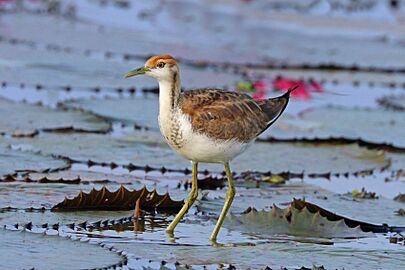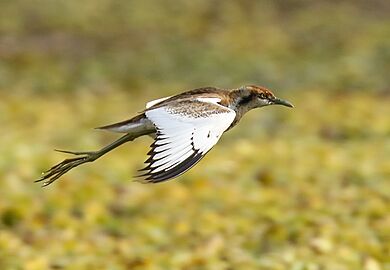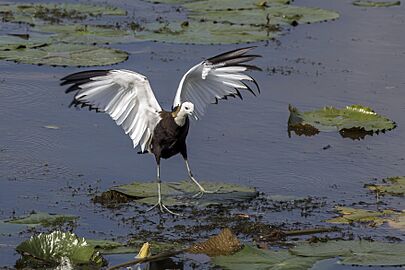Pheasant-tailed jacana facts for kids
Quick facts for kids Pheasant-tailed jacana |
|
|---|---|
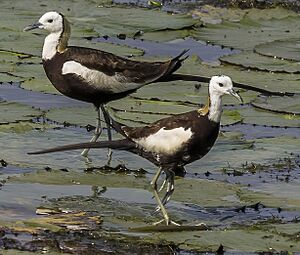 |
|
| The breeding plumage is marked by the elongated central tail feathers, white front and wing, and the silky golden nape feathers | |
| Conservation status | |
| Scientific classification | |
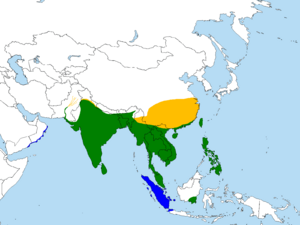 |
|
| Synonyms | |
|
Parra chinensis |
The pheasant-tailed jacana (Hydrophasianus chirurgus) is a type of jacana bird. It's the only species in its own genus called Hydrophasianus.
Like other jacanas, these birds have very long toes and nails. This helps them walk on floating plants in shallow lakes, which is where they like to live. They can also swim or wade in the water. They mostly eat small creatures without backbones, like invertebrates.
You can find pheasant-tailed jacanas in tropical Asia, from Yemen in the west to the Philippines in the east. They sometimes move to different areas depending on the season. They are the only jacanas that travel long distances. They also look different in their breeding and non-breeding seasons. Female jacanas are bigger than males. They are polyandrous, meaning one female lays many clutches of eggs. Different males then raise these eggs.
Contents
What Do They Look Like?
The pheasant-tailed jacana is easy to spot and recognize. It's the longest bird in the jacana family, especially when you include its long tail feathers.
When they are breeding, their body is chocolate brown. Their face is white, and the back of their head is black. White stripes run down the sides of their neck. These stripes separate the white front of the neck from the silky golden-yellow feathers on the back of the neck. Their wings are mostly white. When they fly, their white wings show a black edge. This edge is made by black feathers on the outer parts of the wing.
When they are not breeding, the top of their head and back are dark brown. You might only see a small hint of the golden neck feathers. A dark stripe goes through their eye and down the sides of their neck. This stripe forms a dark "necklace" on their slightly dirty white chest.
Young birds have brown upper parts. Their dark necklace is broken, not a full band. They also have strong, sharp white spurs on their wings. These spurs are longer on females. The bill is bluish-black with a yellow tip when breeding. It's dull brown with a yellowish base when not breeding. Their legs are dark bluish-grey, and their eyes are brown.
Naming the Bird
The French explorer Pierre Sonnerat first described the pheasant-tailed jacana in 1776. He drew the bird and called it "Le Chirurgien de l'Isle de Luzon," which means "the surgeon of the island of Luzon." He thought its long toes and feather extensions looked like the lancets (small knives) surgeons used back then.
Based on Sonnerat's description, Giovanni Scopoli gave the bird its scientific name, Tringa chirurgus, in 1787. The name chirurgus comes from the word "surgeon." Later, the bird was moved to the genus Parra and then to its own genus, Hydrophasianus.
Johann Georg Wagler created the genus Hydrophasianus in 1832. Hydrophasianus means "water pheasant." He did this because the pheasant-tailed jacana is special. It has a slender bill and unique feather shapes on its wings. Also, its different breeding and non-breeding plumages are unique among jacanas.
Where They Live and Their Home
The pheasant-tailed jacana lives and breeds in tropical India, Southeast Asia, and Indonesia. You can also find it in Sri Lanka. It likes small to large lakes that have lots of floating plants.
Most of these birds stay in one place all year. However, those that breed in southern China and the Himalayas fly south for the winter. They go to Southeast Asia and parts of India. For example, in Nanking, China, they leave in November and come back in April.
The species lives in Taiwan, where it is considered endangered. Sometimes, these birds wander far from their usual homes. They have been seen in places like Socotra, Qatar, Australia, and southern Japan. They usually live in lower areas. But in summer, they can fly up into the Himalayas, even at very high altitudes.
Behaviour and Life Habits
Pheasant-tailed jacanas mainly eat insects, snails (molluscs), and other small creatures. They pick these up from floating plants or the water's surface. They find food by walking on plants and also by swimming in the water. They might also accidentally eat some algae or plant material.
You can sometimes see large groups of 50 to 100 jacanas on one body of water. They can get used to people and become quite tame. They usually fly low over the water. When they land, they keep their wings open until they find a firm place to stand.
Their usual call sounds like a mewing me-onp or a nasal teeun when they are in winter flocks. Males and females have different calls during the breeding season. Young birds make a soft cheep sound with their bill closed.
Reproduction and Life Cycle
This jacana breeds on floating plants during the rainy season. In southern India, they breed from June to September.
They are polyandrous, which means one female can lay many clutches of eggs in a single season. Different males then raise these eggs. The female attracts males by flying around them and calling.
The female builds a nest on floating plants using leaves and plant stalks. It has a dip in the middle. A clutch usually has four glossy, dark-olive-brown eggs with black marks. These eggs are laid one by one, usually in the mornings, about 24 hours apart. Once all four eggs are laid, the male starts to incubate them. The female then leaves to find another male.
Males can move the eggs around by holding them between their bill and chest, or between their wings and body. If disturbed, they might even push the eggs to float over water to a safer spot on nearby plants. Nests can be moved up to 15 meters away.
Males near the nest might pretend to have a broken wing or run like a rodent to distract predators. The eggs hatch after 26 to 28 days. For the first few days of incubation, the female protects the nest. She chases away other waterbirds that come too close.
The fluffy chicks can run around soon after hatching. If they feel threatened, or if the male warns them, they will freeze. They might even lie partly underwater with just their bill sticking out.
Pond herons sometimes eat the eggs. Birds like black-winged kites might hunt the chicks.
In Culture
The pheasant-tailed jacana is common in lily ponds in Sri Lanka. Because of its mewing call, people there sometimes call it the "cat teal" or "juana" in Sinhalese. In the Cachar district of Assam, India, it is known as rani didao gophita. This name means "little white water princess."
Images for kids



